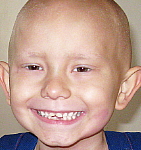Desmoplastic Small Round Cell Tumor (DSRCT)
Introduction
Desmoplastic small round cell tumor (DSRCT) is an aggressive malignant neoplasm that occurs in adolescents and young adults. This tumor can co-express epithelial, neuronal, and mesenchymal markers. Clinical manifestations are often related to widespread abdominal disease. Distant metastases can be present at the time of diagnosis. The molecular hallmark of DSCRT is the EWS-WT1 fusion protein. The t(11;22)(p13;q12) translocation fuses the N-terminal domain of EWS to the C-terminal DNA-binding domain of WT1 resulting in an aberrant transcription factor involved in the pathogenesis of DSRCT. Despite intensive therapy, including surgery, radiotherapy and chemotherapy with or without stem cell transplantation, the 5-year survival continues to be less than 15%. New therapeutic approaches include molecularly targeted therapies and immunotherapy; the role of these modalities is yet to be defined.
Background
Desmoplastic small round cell tumor (DSRCT) was first described in 1989 by Gerald and Rosai who described a distinct type of small round blue cell tumor with a predilection for serosal surfaces such as the peritoneum and the tunica vaginalis that affected mostly Caucasian males in the second or third decade of life.1 DSRCT is generally associated with aggressive features and a poor prognosis. Tumor cells co-express epithelial, mesenchymal and neuronal markers and are thought to originate from a mesothelial or submesothelial progenitor cell with the potential to undergo multilineage differentiation. Because of this, DSCRT is also called "mesothelioblastoma". To date more than two hundred cases have been described in the medical literature. DSRCT exhibits a male predominance of 90%, and 85% of patients are Caucasian. Median age at diagnosis has been reported as 14, 19 and 25 years of age in different series.1-4 Several treatment modalities are used including surgery, radiotherapy and chemotherapy. Unfortunately, these modalities frequently do not provide a durable response, and the prognosis for patients with DSRCT remains poor. Despite aggressive therapy, 3-year overall survival has been estimated at 44% and the 5-year survival rate remains around 15%.5

Clinical Manifestations
In most cases, DSRCT presents as an abdominal mass with peritoneal and omental implants. Associated symptoms may include crampy abdominal pain, weight loss and constipation. The most common presentation is bulky abdominal disease present in a young adult, often males. Other reported sites of disease include pleura, ethmoid sinuses, scalp, hand, posterior cranial fossa, pancreas, ovary, paratesticular and kidney. Symptoms related to extra-abdominal tumors vary, and include scoliosis, chronic sinusitis, and pain. Erectile dysfunction has also been described.1-3,5-9 DSRCT is regional; the major bulk of these tumors is intraabdominal. Liver metastases are common at diagnosis and relapse; other distant sites include lymph nodes, lung and bones. Interestingly, DSRCT has been documented as an incidental finding during a cesarean section. Another peculiar sign on presentation is known as a "Sister Mary Joseph nodule," which is an occasionally painful lump in the umbilicus secondary to metastatic cancer in this location (Figure 1).10,11 More than 40% of patients have distant metastases at the time of diagnosis, mostly located in the liver, lungs, and lymph nodes (Figure 1).
Diagnosis and Pathological Findings
Imaging studies are often suggestive but non-specific. Abdomen CT usually demonstrates bulky, heterogeneous masses located in the abdomen and pelvis with a peritoneal component (Figure 1). These masses are frequently hypoechoic on ultrasound. MRI findings include lesions with hyperintense T2 –weighted signal and an isointense signal on T1-weighted sequences.12
[18F] fluorodeoxyglucose-positron emission tomography (FDG-PET/CT) is often used at diagnosis and during surveillance. In a recent study,13 FDG-PET/CT was found to be superior to conventional imaging in the detection of lymph node and bone involvement in children with sarcoma. Unfortunately no patients with DSRCT were included in the study. PET/CT was also found to be accurate in the early detection of isolated relapse of DSRCT after therapy.14
Once an intra-abdominal tumor is found, histologic diagnosis should be established.4,5 The differential diagnosis for small round blue cell tumors such as DSRCT includes Ewing sarcoma family tumors, rhabdomyosarcoma, neuroblastoma, lymphoma, synovial sarcoma, ectomesenchymoma and blastemic Wilms’ tumor in children; and small cell carcinoma, carcinoid tumor, neuroendocrine carcinomas, Merkel cell carcinoma and small cell mesothelioma in adults.
DSRCTs often reach considerable size in the abdominal cavity prior to diagnosis: a mean size of 10 cm has been described. Macroscopically, they are solid, firm, multilobulated gray-white masses where cystic areas can also be found. Tissue sampling via open or needle core biopsies is the method most consistently described; however, the use of cytology-based diagnosis performed on fine needle aspiration samples as well as ascitic and pleural fluid is an attractive alternative. The correct diagnosis of DSRCT on fine needle aspiration specimens is challenging and requires expertise in the utilization of ancillary techniques such as immunocytochemistry and flow-cytometric immunophenotyping. When available, the use of RT-PCR detection of the EWS-WT1 transcript is a way of increasing diagnostic accuracy using less invasive techniques.5,15,16
Histologic examination shows small cells that can be round, ovoid or spindled usually grouped in clumps, cords, nests or sheets. These cells contain hyperchromatic nuclei with condensed chromatin and eosinophilic cytoplasm. Mitotic figures are common. The extensive collagenous stroma is characteristic, and desmoplasia (from the Greek desmos, "a band or felter" and plassein, "to form or to mold"), is a distinctive feature to this tumor.

A polyphenotypic pattern of immunohistochemical markers has been described. DSRCT express antigens related to different cell lineages, including:
- Epithelial: cytokeratin, epithelial membrane antigen.
- Mesenchymal: desmin (characteristic dot-like pattern), vimentin.
- Neural: neuron-specific enolase, synaptophysin.
CD99, a marker associated with the Ewing’s sarcoma family of tumors, can be positive in as many as 23% of cases (Figure 2). Even though the WT1 protein can be detected in a high proportion of cases by immunohistochemistry, the most specific diagnostic tool is the presence of the EWS-WT1 gene fusion that can be detected by RT-PCR and FISH.1,2,4,17
Molecular Analysis
DSRCT seems to originate from an undifferentiated cell with multilineage potential, exemplified by a report of one patient whose tumor underwent chemotherapy-induced rhabdomyoblastic differentiation with expression of Myo-D and myogenin, both muscle markers. The molecular hallmark of DSCRT is the EWS-WT1 reciprocal translocation. EWS is located on chromosome 22 at 22q12. It encodes a putative RNA binding protein, which is a member of the TET family of proteins. These proteins are thought to have roles in both transcription and splicing. EWS translocations are associated with other sarcomas; with the EWS-FLI1 and EWS-ERG translocations in Ewing’s Sarcoma the best characterized examples. WT1 (Wilms’s tumor suppressor gene) is located on chromosome 11, at 11p13. The WT1 protein contains a zinc-finger DNA-binding domain and is involved in transcriptional and post-transcriptional regulation of numerous target genes. WT1 plays an important role in urogenital development. Different protein isoforms are generated via alternative mRNA splicing; the inclusion of a lysine, threonine and serine sequence (KTS) has gained particular interest since the KTS+ variant has decreased DNA-binding affinity and could have different transcriptional targets than the KTS- isoform.3,18-20
The t (11;22)(p13;q12) translocation fuses the N-terminal domain of EWS to the C-terminal DNA-binding domain of WT1. This chimeric protein functions as an aberrant transcription factor involved in the pathogenesis of DSCRT. Phosphorylation of the fusion protein by kinases such as C-Abl decreases DNA binding,21-22 suggesting that the activity of EWS-WT1 could be regulated by environmental signals. The EWS-WT1 translocation product plays a role in the regulation of the expression of several genes potentially involved with oncogenesis, including IGF-1 receptor, PDGFα, PAX2-2, WT-1, ENT4, TALLA-1 and IL-2/15Rβ.23-26 CCN2 (connective tissue growth factor) has been shown to be highly expressed in DSRCT, and could have an autocrine or paracrine role in disease progression.27 In a DSRCT cell line, the mTOR inhibitor rapamycin downregulates the expression of EWS-WT1 and induces apoptosis;28 however, the sole report of a DSRCT patient treated with rapamycin alone did not demonstrate a clinical response, possibly due to up regulation of alternative pathways such as IGF1R signaling.29 Therefore, though mTOR inhibition may play a role in the treatment of DSCRT, it will probably be in combination with other agents, rather than as monotherapy.
Treatment
DSRCT is a very aggressive neoplasm with a 5-year survival of less than 15%. Treatment options include surgery, radiotherapy, chemotherapy with or without stem cell transplantation, and recently introduced molecularly targeted therapies. Unfortunately there is no standard therapeutic regimen described since no modality is clearly superior to any other. Surgery is usually extensive and often includes excision of the omentum, splenectomy and lymph node resections. Due to the invasive nature of this tumor, complete resection with negative margins is usually not possible. Debulking surgery has been described as an attempt to eliminate 90% of the tumor bulk.5
In addition to surgery and radiation therapy, local control options for DSRCT (particularly metastatic disease) include radiofrequency ablation, gammaknife, cryoablation, embolization and chemoembolization. These are usually performed in academic centers after careful consideration of individual cases.
| Tumor Location | Treatment Options |
| Peritoneal Disease | Surgery, whole abdominal radiotherapy, continuous hyperthermic peritoneal perfusion |
| Liver Metastases | Surgery, stereotactic radiosurgery, radiofrequency ablation, cryoablation, 90Y-microspheres |
| Lung Metastases | Surgery, stereotactic radiosurgery |
| Mediastinal Lymph Nodes | Radiation therapy |
| Bone Metastases | Radiation therapy |
Chemotherapeutic agents utilized include cyclophosphamide, doxorubicin, vincristine, ifosfamide and etoposide (a combination known as P6 protocol) as well as cisplatin, carboplatin, topotecan, temozolamide, vinorelbine and irinotecan. High-dose chemotherapy with autologous stem-cell rescue has also been attempted, however no significant impact in long-term survival has been achieved after transplant.30
Although DSRCTs are generally sensitive to chemotherapy, the response is not enough to achieve cure since patients almost invariably relapse. This could potentially be a reflection of the heterogeneity of the cells within the tumor; where a distinct population of cells ("cancer stem cells") that are less sensitive to chemotherapy and radiotherapy possess the ability to self-renew and retain the capacity to regenerate the tumor bulk after it has been eradicated. This represents a highly attractive hypothesis since it could explain tumor behavior and lead to the identification of new targets for more effective therapies. Unlike other small round blue cell tumors like Ewing’s sarcoma,31 such a stem cell has not been yet identified in DSRCTs.32,33
In a series of 66 patients reported by MSKCC,5 individuals who received multimodal treatment consisting of debulking surgery, whole abdominopelvic radiation34 and the P6 chemotherapy regimen had a 3-year survival of 55% (29/66), compared to 27% in those patients who did not receive all three therapies. In this series, patients who underwent tumor resection had a 58% 3-year survival rate whereas no survivors were found in the non-surgical group. This may represent a difference in tumor extension at the time of diagnosis; however a therapeutic advantage of surgical resection has been suggested. A retrospective series of 11 pediatric patients (10 males, median age 14 years) treated at St Jude with multimodal therapy includes 3 survivors (at 23 months, 2 years and 8 years from diagnosis). Two of these patients presented with localized extra abdominal disease. In this series, three patients with extra abdominal disease are reported: one with a paratesticular mass, one with a submental mass and one with mediastinal disease. Two of these three patients were long-term survivors. It is still unclear whether extra abdominal disease is less aggressive or if a more effective debulking surgery had an impact in this positive outcome.4
Future Directions
Current treatment modalities are highly toxic, with numerous side effects, and are not sufficiently effective. Recent advances in the understanding of the molecular pathophysiology of DSRCT should lead to the development of effective molecularly targeted therapies with fewer side effects. For example, Leflunomide (SU101) is a platelet-derived growth factor (PDGF) receptor inhibitor that acts by blocking PDGF-stimulated receptor autophosphorylation and subsequent cell-cycle progression. This compound also inhibits dihydro-orotate dehydrogenase thus interfering with pyrimidine biosynthesis. In a phase I trial where 2/27 patients had DSRCT, one of them exhibited a significant delay in progression of the disease and marked improvement in symptoms (pain). Because EWS-WT1 upregulates PDGF receptor, this compound is a rational drug to test for this disease.24,35 Sunitinib is a multikinase inhibitor that targets VEGFR 1, 2 and 3, PDGFR-α, PDGFR-ß, KIT, FLT-3, RET and CSF-1. One patient with DSRCT who received sunitinib during a recent trial achieved stable disease during 56 weeks prior to progression.36,37 Current open trials of agents targeting signal transduction pathways include the evaluation of imatinib mesylate (in an attempt to interfere with PDGF receptor signaling) and AMG 479 (IGF-1 receptor blockade).38-40 Androgen receptors and c-kit have been found to be expressed at high levels in refractory tumors; however the therapeutic potential of these findings requires further investigation.41
Other potential therapeutic targets include ENT4, a direct transcriptional target of EWS/WT126 that is inhibitable by the organic cation transport inhibitor, cimetidine42 and CCN2, which is inhibited by lovastatin.43
Immunotherapy approaches to DSRCT are also under investigation. DSRCT cells express the disialoganglioside GD2 on their surface, and this antigen has been studied as a potential target for immunotherapy in neuroblastoma.44 The utilization of monoclonal antibodies such as 3F8 and 8H9 to treat DSRCT has also been proposed. One interesting proposal is the use of intraperitoneal radiolabeled 8H9 as a means to address microscopic residual disease in patients who have been treated with whole abdominal radiation. Although whole abdominal radiation is often recommended for DSRCT patients, its efficacy is limited. It remains unclear if this is because of an intrinsic radioresistance of DSRCT cells, or due to limitations in the dose of abdominopelvic radiation that can be safely delivered. Because locoregional recurrence in the abdomen and pelvis remains a significant concern, regional "radioimmunotherapy" may augment the efficacy of whole abdominal radiation. In addition, a trial involving chemotherapy followed by allogeneic peripheral blood stem cell transplantation is currently in progress at the National Cancer Institute.45
Other treatment modalities, such as the use of continuous hyperthermic peritoneal perfusion (CHPP) with cisplatin in order to treat peritoneal malignancies (MD Anderson Cancer Center) are also being investigated. CHPP has been described as a therapeutic alternative in adult patients with carcinomatosis secondary to ovarian carcinoma, mesothelioma and colon adenocarcinoma. Two pediatric patients with DSRCT and widespread peritoneal implants were treated with cytoreductive surgery and CHPP with cisplatin. This modality appeared to be safe and relatively well tolerated. A phase I trial is ongoing at MD Anderson Cancer Center.46-48
Conclusion
In summary, DSRCT is a highly aggressive sarcoma with a dismal prognosis for which the ideal therapeutic modality is yet to be determined. Current therapeutic approaches remain highly toxic and have not achieved complete disease control. The development of molecularly targeted agents, likely in combination with conventional approaches, could potentially have significant impact on the treatment of this disease.





